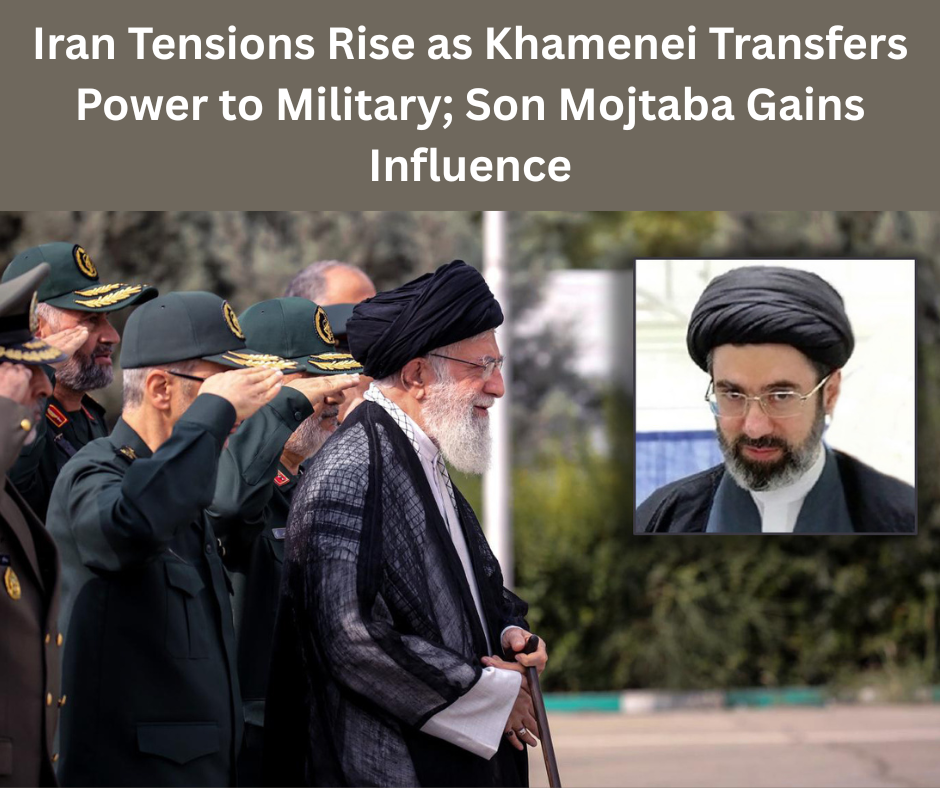Iran Tensions Escalate as Khamenei Shifts Power to Military Leadership
As Iran tensions with Israel intensify and pressure mounts from the United States, Supreme Leader Ayatollah Ali Khamenei has taken a significant and symbolic step by transferring major authority to Iran’s military command. According to reports, the Supreme Council of the Iranian military, including the influential Islamic Revolutionary Guard Corps (IRGC), has been granted expanded powers, signaling a potential shift in how Iran handles both domestic unrest and external threats.
Amid these developments, Khamenei has reportedly moved into an underground bunker in northeastern Tehran, accompanied by close family members, including his son, Mojtaba Khamenei. Analysts believe this move reflects deep concerns about both international conflict and internal stability.
The IRGC’s Role in the Growing Iran Tensions
In the midst of rising Iran tensions, the IRGC has once again emerged as the cornerstone of Tehran’s military and political response. Unlike the regular armed forces, the IRGC operates directly under the Supreme Leader, making it a critical tool in both national defense and political enforcement.
Established after the 1979 Islamic Revolution, the IRGC has grown into a vast organization with its own air force, navy, and intelligence networks. With a reported strength of over 150,000 personnel, the IRGC plays a crucial role in shaping Iran’s foreign and domestic policies, especially during times of crisis.
Its elite forces, along with the paramilitary Basij, are often deployed to suppress internal dissent—most recently during nationwide protests in 2022. The IRGC’s deep ties to Iran’s clerical establishment make it a formidable force that Khamenei heavily relies upon during rising Iran tensions.
The U.S. Perspective on IRGC Amid Iran Tensions
The United States designated the IRGC as a Foreign Terrorist Organization in 2019, citing its involvement in attacks against American interests in the Middle East. The State Department accused the IRGC of plotting terror attacks and claimed it was responsible for the deaths of over 600 American service members in Iraq.
Former President Donald Trump’s administration emphasized Iran’s missile program and the IRGC’s influence as major reasons for exiting the 2015 nuclear deal. With Iran tensions climbing again in 2025, the U.S. continues to monitor the IRGC’s actions closely, especially after the Israeli airstrikes that reportedly killed top commanders of the IRGC’s air division.
Mojtaba Khamenei: Iran’s Emerging Power Broker?
One of the most significant developments amid the current Iran tensions is the growing visibility of Mojtaba Khamenei, the Supreme Leader’s son. Reports suggest that Mojtaba has played an increasingly strategic role behind the scenes for the past two decades. Now, with his father delegating more authority, Mojtaba is being viewed as a central figure in coordinating between various factions, military leaders, and clerical institutions.
Insiders have described Mojtaba as a mid-ranking cleric with strong ties to the IRGC, and some even speculate that he could be groomed as Khamenei’s successor. His influence over Iran’s intelligence and security affairs continues to grow, placing him at the core of the regime’s survival strategy.
Iran Tensions Intensify After Israeli Airstrikes
Tensions between Iran and Israel escalated dramatically following Israeli airstrikes on June 13, 2025, which reportedly targeted an underground command center. According to military sources, the attack eliminated several high-ranking IRGC officials, including General Amir Ali Hajizadeh, head of the aerospace division.
The airstrikes marked one of the most severe blows to Iran’s military leadership in recent history. Over 200 individuals, including both officials and civilians, are believed to have been killed in the strikes. This loss has further destabilized the IRGC’s command structure and intensified Iran tensions across the region.
Iran’s Regional Strategy and Military Power Play
Since coming to power in 1989, Khamenei has leaned on the IRGC to extend Iran’s influence throughout the region, particularly in Syria, Iraq, Lebanon, and Yemen. This network of proxy operations forms a critical part of Iran’s strategy to counter Western and Israeli influence.
Even as Iran tensions climb, Tehran continues to showcase its military might, unveiling missile systems and expanding drone capabilities. The direct reporting line between the IRGC and Khamenei has allowed Iran to bypass traditional government oversight, giving military leaders unprecedented autonomy to carry out sensitive operations.
The Fallout and Warnings from Israel
Following the deadly airstrikes, Israeli Defence Minister Israel Katz issued a stern warning to Ayatollah Khamenei. Citing the fate of former Iraqi dictator Saddam Hussein, Katz implied that Iran’s Supreme Leader could face a similar end if Tehran continues its military offensives.
The warning has fueled fears of an all-out regional war, with Iran tensions reaching a boiling point. Iran’s continued missile attacks on Israeli targets and threats of retaliation indicate that diplomacy is rapidly failing to contain the crisis.
Conclusion: What’s Next Amid Rising Iran Tensions?
As Iran tensions deepen, the balance of power within Tehran appears to be shifting. Khamenei’s reliance on the IRGC and growing visibility of Mojtaba Khamenei suggest a calculated attempt to consolidate control and ensure regime survival.
With global powers watching closely, the next moves by Iran and Israel could determine the course of Middle Eastern geopolitics for years to come. The stakes are high, and the possibility of further escalation looms large.
Read more: TCS Ends Remote Work
